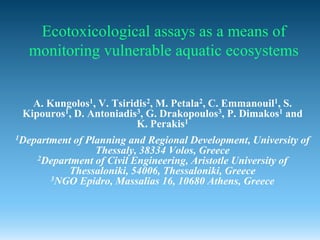
Ecotoxicological assays as a means of monitoring vulnerable aquatic ecosystems
- 1. Ecotoxicological assays as a means of monitoring vulnerable aquatic ecosystems A. Kungolos1, V. Tsiridis2, M. Petala2, C. Emmanouil1, S. Kipouros1, D. Antoniadis3, G. Drakopoulos3, P. Dimakos1 and K. Perakis1 1Departmentof Planning and Regional Development, University of Thessaly, 38334 Volos, Greece 2Department of Civil Engineering, Aristotle University of Thessaloniki, 54006, Thessaloniki, Greece 3NGO Epidro, Massalias 16, 10680 Athens, Greece
- 2. How to determine the hazard resulting from pollution? Chemical approach Chemical analyses of the pollutants Biomonitoring Bioassays: effects of chemicals, natural waters, pollutants, wastes,…on aquatic and terrestrial living organisms
- 3. Why do we need Monitoring? Water quality may be affected by: Spills of oil and industrial products from tanks, pipelines Pesticides from agricultural area, leaching pathogens Endocrine disrupting chemicals Neurotoxins, hepatotoxins from algae blooms Contamination from terrorist attack (toxins, microbes, viruses, radioactive compounds) Accidents, sabotage etc.
- 4. Why do we need Biomonitoring? It is impossible to analyze all chemical substances, which are brought into nature by human Scientists suggest that there are more than 100 000 harmful chemicals Even with the most advanced instruments it is not yet possible to detect them all With the help of biomonitoring, a much broader view of the possible dangerous effects can be detected
- 5. Toxicity testing used in our Lab in the University of Thessaly, Greece 15 min inhibition test of the photobacterium Vibrio fischeri 72 h growth inhibition test of the microalae Pseudokirchneriella subcapitata 24 or 48 h immobilization test of the crustacean Daphnia magna
- 6. Photobacterium Vibrio fischeri (Microtox test) Bioluminescence inhibition Normal bioluminescence Photobacterium Vibrio fischeri Contaminated sample is added!! Bioluminescence measurement at exposure Microtox M500 analyzer time 5, 15 and 30 min
- 7. Microalgae Pseudokirchneriella subcapitata (Algaltoxkit F) mobilization Immobilized algae Measurement of the optical density (at 670 nm) after 72 h
- 8. Crustacean Daphnia magna (Daphtoxkit F magna) Hatching of the ephippia Exposure for 24 h at 20 oC Addition of the samples and live Measurement of the organisms in multiwell test plate immobilized/dead organisms
- 9. Applications of ecotoxicity testing Toxicity tests have been used for: Marine and fresh waters biomonitoring Toxicity testing of wastewaters and soils Toxicity testing of fly ash leachates Toxicity assessments of pure compounds, heavy metals and pesticides Wastewater treatment plant applications
- 10. Correlation between the toxicity of lignite fly ash leachates towards D. magna and the concentration of Cr(VI) detected in the leachates Correlation coefficient, r= 0.961 Level of significance, p<0.01
- 11. Investigation of the interactive toxic effects of chemicals on live test organisms MODE OF INTERACTION •Additive if there is no significant difference between expected and observed effect • Synergistic if the observed effect is significantly higher • Antagonistic if the observed effect is significantly lower
- 12. Expected and observed effects Expected by a model based on the theory of probabilities P(E) = P1 + P2 – P1P2/100 where P(E): the theoretically expected additive effect of a binary chemical mixture Pi : the effect caused by a certain concentration of a chemical when it acts alone Observed The measured effect of the binary chemical mixture
- 13. Combined effect of Cu2+ and Zn2+ on V. fischeri (Synergistic effect) 100 Cu 2+ Zn 2 + Ex pe cte d (m g /L ) (m g /L ) O bs e rve d A: 0.117 0.432 B : 0.117 0.864 80 C: 0.117 1.727 D: 0.168 1.727 E : 0.252 0.432 F: 0.252 0.864 60 Eff e c t, % G : 0.252 1.727 40 20 0 A B C D E F G C onc e ntr ation c ombinations
- 14. Comparison between theoretically expected and observed immobilization for the combined effect of metalaxyl-M and copper on D. magna (antagonistic action) 100 M eta la x y l-M Cu E xp ected (m g /L ) (m g /L ) O b served A : 10 0 .0 5 B: 10 0 .1 0 80 C : 30 0 .0 5 D : 30 0 .1 0 Im m ob ilization , % E: 60 0 .0 5 60 F: 60 0 .1 0 40 20 0 A B C D E F C on cen tration com b in ation s
- 15. Current project on ecotoxicity testing Ecotoxicity testing of selected lake waters and treated wastewater effluents - Lakes Koronia and Karla - Treated wastewater efluents from Tyrnavos region - Ecotoxicity testing using the photobacterium Vibrio fischeri, the crustacean Daphnia magna and the algae Pseudokirchneriella subcapitata The research is funded by Ministry of Environment, Energy and Climatic Change/Green Fund programme: Environmental Research- Innovation- National Cooperations 2012”: “Improvement of monitoring water quality with the use of ecotoxicological assays”
- 16. Environmental Chemical analyses + Bioassays = Hazard Assessment The only way to get an “integrated” answer to the hazard caused by pollutants to the environment, is to expose organisms of the receiving environment to these pollutants Chemical analysis in many cases deals with a restricted number of compounds due to financial and technical limitations For a “real hazard” monitoring, phenomena such as bioavailability, synergistic or antagonistic effects on the biota have to be examined A single toxicity test does not tell whether other important groups of biota are affected by exposure to the same samples. It is thus necessary to use a battery of tests with species representative of the different links in the trophic chains
- 17. SECOTOX 2013 & CEMEPE Conference (Conference on Environmental Management, Engineering, Planning and Economics) Myconos, June 24 – 28, 2013 THANK YOU FOR YOUR ATTENTION!